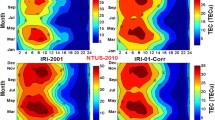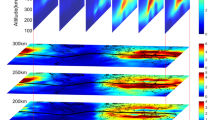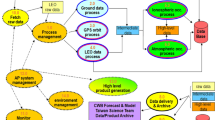Abstract
The FormoSat-3/ Constellation Observing System for Meteorology, Ionosphere and Climate (FS3/COSMIC) has been proven a successful mission on profiling ionospheric electron density \(( {N_e })\) using the radio occultation (RO) technique. A follow-on program (called FS7/COSMIC2) is now in progress. The FS3/COSMIC follow-on mission will have six 24\(^{\circ }\)-inclination and 550-km low Earth orbiting (LEO) satellites and six 72\(^{\circ }\)-inclination and 750-km LEO satellites to receive Tri-G (GPS, GLONASS, and Galileo) satellite signals. FS7/COSMIC2 RO observations were simulated in this study by calculating limb-viewing GNSS-to-LEO TEC values separately through two independent ionospheric models (the TWIM and NeQuick models). We propose a compensatory Abel-inversion scheme to improve vertical \(N_e \) profiling and three-dimensional (3D) \(N_e \) modeling in this FS7/COSMIC2 simulation study with future real observations. In this FS7/COSMIC2 feasibility study the number of RO observations will increase of around 10 times compared with FS3/COSMIC, and the windowing day number to collect \(N_e \) profiles and to derive every half-hour 3D \(N_e \) model could be decreased from 30 to 3 days. The results show that the root-mean-square (RMS) foF2 and hmF2 difference improvements are 46 % (32 %) and 21 % (4.6 %), respectively, in relative percentage over the standard Abel inversion at the TWIM-background (NeQuick-background) simulation experiment. The RMS modeling errors are about one order less than those from FS3/COSMIC simulations.









Similar content being viewed by others
References
Aragon-Angel A, Hernandez-Pajares M, Juan JM, Sanz J (2009) Obtaining more accurate electron density profiles from bending angle with GPS occultation data: FORMOSAT-3/COSMIC constellation. Adv Space Res 43:1694–1701. doi:10.1016/j.asr.2008.10.034
Aragon-Angel A, Hernandez-Pajares M, Zornoza JMJ, Subirana JS (2010) Improving the Abel transform inversion using bending angles from FORMOSAT-3/COSMIC. GPS Solut 14:23–33. doi:10.1007/s10291-009-0147-y
Borsche M, Kirchengast G, Foelsche U (2007) Tropical tropopause climatology as observed with radio occultation measurements from CHAMP compared to ECMWF and NCEP analyses. Geophys Res Lett 34:L03702. doi:10.1029/2006GL027918
Brunini C, Azpilicueta Francisco, Nava Bruno (2013) A technique for routinely updating the ITU-R database using radio occultation electron density profiles. J Geodesy. doi:10.1007/s00190-013-0648-x
Cucurull L, Derber JC, Treadon R, Purser RJ (2007) Assimilation of global positioning system radio occultation observations into NCEP’s global data assimilation system. Mon Weather Rev 135:3174–3193. doi:10.1175/MWR3461.1
Davis HF (1989) Fourier series and orthogonal functions. ISBN-13:978–0486659732. Dover Publications Inc, New York
Fjeldbo G, Eshleman VR (1969) Atmosphere of Venus as studied with the Mariner V dual radio frequency occultation experiment. Radio Sci 4:879–897. doi:10.1029/RS004i010p00879
Hajj GA, Romans LJ (1998) Ionospheric electron density profiles obtained with the Global Positioning System: results from the GPS/MET experiment. Radio Sci 33(1):175–190. doi:10.1029/97RS03183
Hajj GA, Lee LC, Pi X, Romans LJ, Schreiner WS, Straus PR, Wang C (2000) COSMIC GPS ionospheric sensing and space weather. Terr Atmos Ocean Sci 11(1):235–272
Hernández-Pajares M, Juan JM, Sanz J (2000) Improving the Abel inversion by adding ground GPS data to LEO radio occultation in ionospheric sounding. Geophys Res Lett 27(16):2743–2746. doi:10.1029/2000GL000032
Kursinski ER, Hajj GA, Schofield JT, Linfield RP, Hardy KR (1997) Observing Earth’s atmosphere with radio occultation measurements using the Global Positioning System. J Geophys Res 102:23429–23465. doi:10.1029/97JD01569
Leitinger R, Radicella S, Nava B (2002) Electron density models for assessment studies—new developments. Acta Geodet Geophys Hung 37:183–193. doi:10.1556/AGeod37.2002.2-3.7
Leroy SS, Anderson JG, Dykema JA (2006) Testing climate models using GPS radio occultation: a sensitivity analysis. J Geophys Res 111:D17105. doi:10.1029/2005JD006145
Macalalad EP, Tsai L-C, Wu J, Liu CH (2012) Application of the TaiWan Ionospheric Model to single-frequency ionospheric delay corrections for GPS Positioning. GPS Solut. doi:10.1007/s10291-012-0282-8
Macalalad EP, Tsai L-C, Wu J (2014) Performance evaluation of different ionospheric models in single-frequency code-based differential GPS positioning. GPS Solut. doi:10.1007/s10291-014-0422-4
Pi X, Mannucci AJ, Iijima BA, Wilson BD, Komjathy A, Runge TF, Akopian V (2009) Assimilative modeling of ionospheric disturbances with FORMOSAT-3/COSMIC and ground-based GPS measurements. Terr Atmos Ocean Sci 20:273–285. doi:10.3319/TAO.2008.01.04.01(F3C)
Press WH, Teukolsky SA, Vetterling WT, Flannery BP (1992) Numerical recipes in C: the art of scientific computing, 2nd edn. ISBN 0-521-43108-5. Cambridge Univ. Press, New York
Rocken C, Anthes R, Exner M, Hunt D, Sokolovskiy S, Ware R, Gorbunov M, Schreiner W, Feng D, Herman B, Kuo Y, Zou X (1997) Analysis and validation of GPS/MET data in the neutral atmosphere. J Geophys Res 102(D25):29849–29866. doi:10.1029/97JD02400
Schreiner WS, Sokolovskiy SV, Rocken C, Hunt DC (1999) Analysis and validation of GPS/MET radio occultation data in the ionosphere. Radio Sci 34(4):949–966. doi:10.1029/1999RS900034
Schreiner WS, Yue X, Kuo Y-H, Mamula D, Ector D (2012) Satellite constellations for space weather and ionospheric studies: status of the COSMIC and planned COSMIC-2 missions. In: Proceedings of 9th AMS annual meeting, pp 1–16, New Orleans, LA, USA
Straus PR (1999) Correcting GPS occultation measurements for ionospheric horizontal gradients. In: Proceedings of ionospheric effects symposium, Alexandria, VA, June
Tricomi FG (1985) Integral equations. Dover, Mineola, New York, p 238
Tsai L-C, Tsai WH (2004) Improvement of GPS/MET ionospheric profiling and validation with Chung-Li ionosonde measurements and the IRI. Terr Atmos Ocean Sci 15(4):589–607
Tsai L-C, Liu CH, Hsiao TY, Huang JY (2009) A near real-time phenomenological model of ionospheric electron density based on GPS radio occultation data. Radio Sci 44. doi:10.1029/2009RS004154
Tsai L-C, Kevin Chang K, Liu CH (2011) GPS radio occultation measurements on ionospheric electron density from low Earth orbit. J Geodesy. doi:10.1007/s00190-011-0476-9
Tsai L-C, Macalalad EP, Liu CH (2014a) TaiWan Ionospheric Model (TWIM) prediction based on time series autoregressive analysis. Radio Sci 49. doi:10.1002/2014RS005448
Tsai L-C, Tien MH, Chen GH, Zhang Y (2014b) HF radio angle-of-arrival measurements and ionosonde positioning. Terr Atmos Ocean Sci 25:401–413. doi:10.3319/TAO.2013.12.19.01(AA)
Tulasi Ram, S, Su S-Y, Liu CH (2009) FORMOSAT-3/COSMIC observations of seasonal and longitudinal variations of equatorial ionization anomaly and its interhemispheric asymmetry during the solar minimum period. J Geophys Res 114:A06311. doi:10.1029/2008JA013880
Wu X, Hu X, Gong X, Zhang X, Wang X (2009) An asymmetry correction method for ionospheric radio occultation. J Geophys Res 114:A03304. doi:10.1029/2008JA013025
Yue X, Schreiner WS, Kuo Y-H (2012) A feasibility study of the radio occultation electron density retrieval aided by a global ionospheric data assimilation model. J Geophys Res 117(A08301). doi:10.1029/2011JA017446
Yue X, Schreiner WS, Pedatella N, Anthes RA, Mannucci AJ, Straus PR, Liu JY (2014) Space weather observations by GNSS radio occultation: from FORMOSAT-3/COSMIC to FORMOSAT-7/COSMIC-2. Space Weather 12. doi:10.1002/2014SW001133
Acknowledgments
This work has been supported by Ministry of Science and Technology, Taiwan, R.O.C. through Project Nos. MOST 103-2111-M-008-022 and NSC 102-2923-M008-002-MY3. The authors express their appreciation to Ionosphere Radio Propagation Unit of the T/ICT4D Laboratory for providing the NeQuick model source code. The authors would also like to thank UCAR’s CDAAC and NSPO Satellite Operations Control Center (SOCC) for providing FS3/COSMIC satellites data.
Author information
Authors and Affiliations
Corresponding author
Rights and permissions
About this article
Cite this article
Tsai, LC., Su, SY., Liu, C.H. et al. Ionospheric electron density profiling and modeling of COSMIC follow-on simulations. J Geod 90, 129–142 (2016). https://doi.org/10.1007/s00190-015-0861-x
Received:
Accepted:
Published:
Issue Date:
DOI: https://doi.org/10.1007/s00190-015-0861-x




